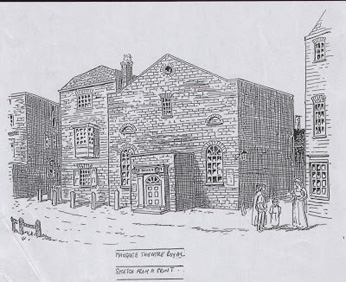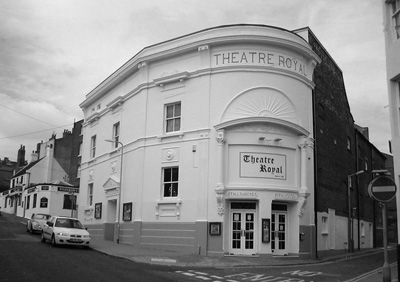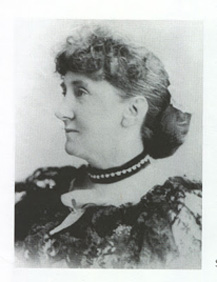Photo Left = Theatre Royal In 1787. Photo Middle = Theatre Royal Present Day. Photo Right = Manager Miss Sarah Thorne (1836 - 1899).



Fred Archer was probably the first to make a national story about the hauntings at the Theatre Royal, Margate. According to the local papers a progressive series of hauntings began in 1918, when the ghost of Sarah Thorne was first seen. Miss Thorne, incidentally, is believed to have come back to protest at the modern usage of the theatre, such as bingo and other gambling games. So frightening was her wraith to some witnesses that the police were called in to investigate, but they found nothing untoward.
Archer says that the theatre "where there is a trapdoor leading to what was a smuggler's cave" probably boasts the most diverse psychic happenings in. the theatrical world: "an orange-coloured ball of light"; "a scream which starts backstage and seems to travel across the stage and finally exits through the stagedoor" ; and "the appearance of a ghost in one of the boxes who draws back the curtains if they are closed."
The latter phenomenon was witnessed by Macqueen Pope, who believed this spectre to be an actor who had committed suicide by throwing himself from the box into the orchestra pit sometime in the early 1900's. Joseph Braddock dates the suicide to late Georgian or early Victorian times:
An actor from a company playing at the theatre was dismissed for some reason, and on the next evening he bought himself a box for the performance. During the course of the play he committed suicide by throwing himself out of the box into the orchestra pit. Some time during the first decade of our century the wraith of a man was seen sitting in the box so often that the management was obliged to withdraw the box from sale, leaving it permanently curtained, until finally it was bricked up.
This, however, would predate the building of the Theatre Royal on the Addington Street site. Alternatively, the story as Braddock heard it could have referred to the eighteenth-century site of Margate's theatre tradition, and was perhaps a transference of the myth.
Modern testimony of the theatre's hauntings comes from Alfred Charles Tanner, who was interviewed about his sightings in 1966 by Dr. A. R. G. Owen, the distinguished Cambridge parapsychologist, and Victor Sims.
Tanner, it appears, was working during January 1966 on the redecoration of the Theatre Royal when he encountered the ghostly happenings. In order that the redecoration should not interrupt the daytime bingo, Tanner had agreed to work through the night. His first night's work passed without incident dent, but during his second work stint he heard a series of sounds coming from the stage - as if someone were whispering. He stopped work for a few minutes to investigate, but could find no reason for the noises. Working on, he heard the natural creakings of the floorboards. Then, however, he heard the sounds of footsteps just in front of the stage and moving toward him.
As he turned around to see who was there, the footsteps stopped. No one was to be seen. Suddenly, testifies Tanner, he heard the door of the box office bang violently. Again no one was to be seen. The decorator was entirely alone in the old theatre Tanner resumed painting in the hope that the unusual noises he had heard were "natural." Just as he was getting himself calm again, the phantom footsteps started once more. They came up behind him and halted when he turned. But this time there was something more eerie. Tanner heard an extremely heavy thump on the floor between the front row of seats and the stage-as though a heavy object had fallen there. Charles Tanner looked across at the spot: "I swear I saw the dust rising, just as it would if a real object had hit the carpet." Of course no object was visible, but could this have been the materialised impact of the ghostly suicide's cadaver hitting the floor?
On the following night, Tanner was at work again when he was interrupted once more. This time he saw "a semi-transparent globular object measuring about ten inches across" moving across the stage from left to right. The globe latterly formed the shape of a head before it disappeared. This time Tanner saw curtains by the exit door being moved by an unseen hand.
The next working night Charles Tanner, who now had an assistant, Lawrence Rodgers, was haunted again. Both heard a curious bang from the dress circle. This time the police were called, but no intruders were found.
Certain aspects of these hauntings - the slow movement of the curtains and the bangs and footfalls are typical of poltergeists, as set down by parapsychologists A. R. G. Owen and Raymond Bayliss. But the "face" remains more of an unaccounted mystery.
Following the theories of G. W. Lambert, some persons have said that the "ghostly noises" had something to do with seismic disturbances. But can earthquakes cause localisation of phenomena in the theatre at Margate? Can it localise noises to one position only within a building? Hardly.
Certainly the ghosts at the Theatre Royal, Margate, are best explained as poltergeists, with hallucination as a side effect in the case of the curtains and the "face"- almost as a form of mediumistic talent in terror. Above all the "atmosphere" of this theatre seems to be the most charged in Britain for psychic happenings.
All credits for this article go to http://trm-archive.blogspot.co.uk/